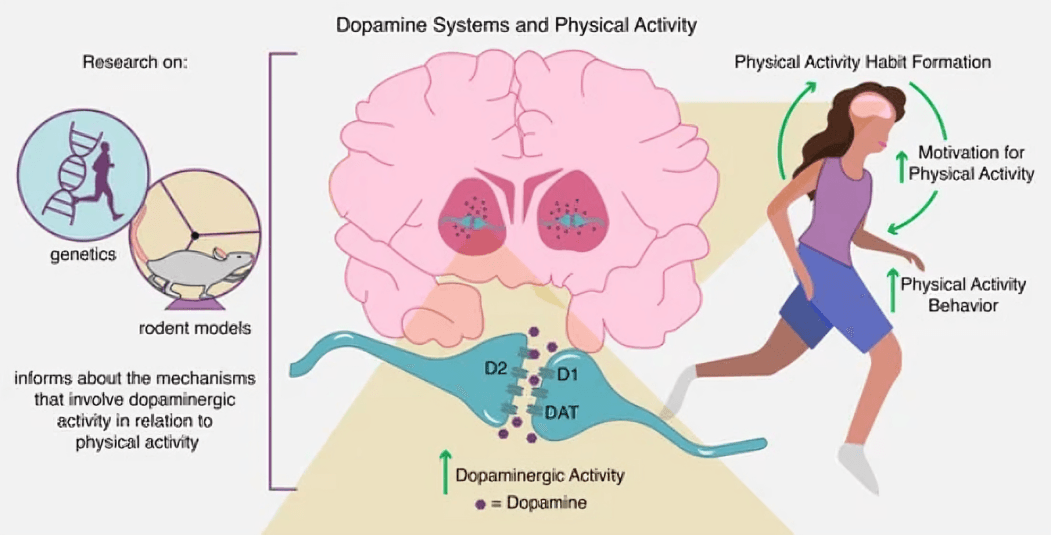
“
Understanding how exercise affects brain chemistry is vital in today’s fast-paced world. Regular physical activity doesn’t just shape the body—it also profoundly transforms the brain’s internal environment. Exercise boosts mood and enhances memory and focus, leading to lasting emotional and mental benefits.1
1
”
The ancient Greek physician Hippocrates once said, “Walking is man’s best medicine.” Today, neuroscience confirms this wisdom. Exercise stimulates endorphins, which act like natural painkillers and mood lifters. 1
Exercise boosts serotonin levels in the brain, a chemical known for balancing mood and promoting feelings of well-being, making it a key reason why workouts can reduce depression symptoms. 2

Dopamine, a neurotransmitter linked with motivation and reward, is released during physical activity, helping improve focus, energy levels, and a sense of personal satisfaction after a workout.
Regular aerobic exercise can promote the release of brain-derived neurotrophic factor (BDNF), a protein that supports neuron growth and cognitive flexibility, enhancing both mood and memory. 3
Cortisol, known as the stress hormone, often drops after moderate exercise, which helps relieve anxiety and restore emotional balance without the need for medication. 4
Exercise increases the volume of the hippocampus, a brain area tied to memory and emotional regulation, making workouts beneficial for long-term mental resilience and mental sharpness. 5
Engaging in rhythmic exercises like running or swimming can induce a “flow state,” where brain chemistry supports deep focus, reduced rumination, and an elevated sense of calm. 6
High-intensity workouts elevate norepinephrine levels, a brain chemical involved in attention and reaction time, sharpening mental clarity and improving overall alertness throughout the day. 7

Even a 20-minute brisk walk can immediately elevate endorphin levels, creating what’s commonly known as a “runner’s high,” a natural mood boost that lasts for hours afterward.
People who engage in consistent physical activity often show better sleep patterns, which further regulates mood by allowing better hormonal balance during crucial brain rest periods. 8
Strength training not only builds muscle but can also increase levels of neuropeptide Y, a brain chemical associated with anxiety reduction and improved stress tolerance. 9
Exercise is linked with increased levels of anandamide, sometimes called the “bliss molecule,” which binds to cannabinoid receptors in the brain to promote a sense of calm and joy. 10
Studies show that regular movement supports GABA (gamma-aminobutyric acid) activity, a neurotransmitter that acts like a brake on anxiety, helping individuals feel more grounded and relaxed. 11
As philosopher Friedrich Nietzsche observed, “All truly great thoughts are conceived while walking.” Walking not only clears the mind—it chemically enhances it by balancing emotion and thought. 12
Exercise triggers the release of endocannabinoids, natural brain chemicals similar to cannabis, which work to reduce pain, lower anxiety, and lift mood—without any side effects. 13
Group exercises, like dance or fitness classes, enhance oxytocin levels—the “bonding hormone”—which improves trust, empathy, and mood through social connection and shared achievement. 14

Teens and children who participate in physical activity show better academic performance and emotional regulation, largely because of the brain’s enhanced chemical environment.
People who regularly do yoga or tai chi demonstrate increased alpha brain wave activity, which is associated with calmness, focus, and peaceful moods even during stressful times. 15
People who walk outdoors in nature experience elevated serotonin and dopamine levels compared to those exercising indoors, highlighting how environment and movement can compound brain benefits. 16
Athletes often experience long-term changes in baseline brain chemistry, resulting in greater mental resilience, faster recovery from stress, and increased motivation in life beyond sports. 17


